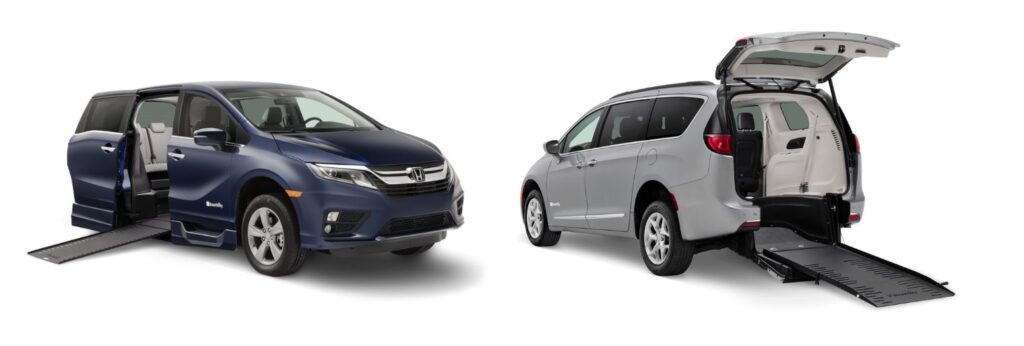
As a caregiver, you must ensure your loved one’s safety and comfort while taking them to doctor’s appointments, social gatherings, or their favorite restaurant. Whether you want to avoid the exorbitant cost of taxi rides or find public transportation unsuitable due to inaccessibility or discomfort, investing in a wheelchair-accessible van may be an ideal solution.
Wheelchair vans come equipped with a host of safety features that can make the journey far less complicated and labor-intensive for caregivers who regularly have to assist their loved ones and ensure a smoother, more enjoyable ride for all involved.
Wheelchair Vans Safety Features for Caregivers
Below are some essential wheelchair van safety features to help caregivers drive with confidence and peace of mind:
Ramp Access for Easy Boarding
Wheelchairs are heavy, bulky, and unwieldy — and when you’re dealing with one that’s also occupied by a person, the process of boarding a vehicle can be quite complicated. Wheelchair van ramps offer an easy and quick solution to this problem by allowing caregivers to transfer their loved ones into a vehicle without lifting or straining themselves. Ramped access systems are also useful for wheelchair users with other conditions, such as muscular dystrophy, cerebral palsy, and post-stroke syndrome.
There are two primary types of wheelchair van ramps: in-floor ramps and fold-out ramps.
In-Floor Ramps
In-floor ramps are stowed beneath the vehicle’s floor when not in use, maximizing interior space and leaving the side passenger doors unobstructed. These ramps often require less physical effort to operate and are less likely to become an obstruction in cramped parking situations.
Fold-Out Ramps
Fold-out ramps, on the other hand, fold inward and rest against the interior door when retracted. They tend to be more resilient in snowy or icy conditions due to their higher ground clearance. Since these ramps have perforated floors, they are much easier to clean and maintain.
Both types of ramps can be used in conjunction with standard rear entry doors or as part of a side-entry system. Plus, both manual and automatic ramps are available, further enhancing convenience and accessibility.
Additionally, wheelchair lifts can also be installed when a vehicle with a ramp is unsuitable for your needs or preferences. Wheelchair lifts serve as motorized platforms that safely transport a wheelchair user in and out of the vehicle, providing additional accessibility and ease for caregivers and their loved ones. There are different types of wheelchair lifts, including inside lifts, outside lifts, and hybrid models, so you can easily choose one according to your requirements.

Wheelchair Securement Systems
Wheelchair securement systems are another crucial component of wheelchair-accessible vans. These systems secure the wheelchair in place, reducing movement during transit. The combination of wheelchair restraints, belts, and occupant protection systems helps increase stability and protects wheelchair users from potential accidents or injuries. This offers extra peace of mind to caregivers that their loved ones will be safe no matter what, even while driving over uneven or bumpy roads.
Many securement systems, such as automated docking systems and retractable tie-downs, are designed for easy operation. This reduces the physical stress on caregivers, who may otherwise have to exert significant effort to manually secure a wheelchair. Some securement systems even include two-way quick-release mechanisms for caregivers to quickly remove a wheelchair occupant in an emergency situation.
High-Quality Suspension Systems
In any vehicle, the suspension system provides maximum control to the driver to manage the vehicle, ensuring a smooth, comfortable ride. For wheelchair vans, this system takes on even greater importance.
A well-designed suspension system helps absorb shocks and vibrations when turning corners or encountering bumps. This helps keep the wheelchair and vehicle stable and reduces the risk of tipping or other accidents.
Vehicles with high-quality suspension systems, such as those found in wheelchair-accessible vans, are much easier to maneuver through traffic and park without causing undue strain on the driver. When selecting a wheelchair van, look for one with an independent front/rear stabilizing system (IFS/RSS) that uses shocks and springs for a smoother ride and better traction on the road.
Like What you're reading? Subscribe to our Newsletter and get new updates directly to your inbox
Accessible Driving Controls
While accessible driving control such as hand controls, steering wheel knobs, and pedal extenders encourages independent driving, they can also provide caregivers greater peace of mind that their loved ones are well-equipped to handle a variety of driving situations without a caregiver’s assistance. This empowerment significantly reduces caregivers’ workload and directs their attention to other important matters.
Visibility Enhancements
Good visibility is crucial for safe driving, and many wheelchair vans often incorporate large windows and panoramic views to provide drivers with a clear view of the road ahead. This helps drivers avoid obstacles or hazards in their path, making driving less stressful for caregivers. Additional enhancements, such as backup and blind-spot cameras, can aid caregivers in navigating through tight spots and busy traffic circumstances, promoting overall safety.
Visibility enhancement features aren’t just for easy navigation on the road. In some cases, optional interior cameras can also be installed to help caregivers keep an eye on passengers, ensuring they’re safe and comfortable during the ride.
Parking Assist Technology
Parking can often be a challenge, especially when driving larger wheelchair-accessible vehicles. For example, when parking you must take care to leave enough space for ramp deployment, ensure that you don’t hit curbs or other obstacles, and avoid obstructing other vehicles. All of this can contribute to a stressful experience for both the driver and their passengers while navigating parking lots.
Fortunately, many accessible vehicles on the market today feature parking assist technology that makes parking easier than ever before.
Advanced parking assist technology, including parking sensors and features like cross-traffic alerts, are almost like extra “eyes” that significantly simplify the parking process, whether parallel parking, maneuvering into tight spaces, or dealing with parking garages. These sensors and cameras provide caregivers with real-time feedback (visual or audio cues) to help avoid collisions.
Clock Mobility: A Solution for Caregivers
Clock Mobility provides more than just vehicles; we deliver peace of mind, independence, and the freedom to navigate life on your terms. Our wheelchair vans come with state-of-the-art features that assist caregivers while navigating the busy city streets, making a long journey across the country, or winding their way through narrow suburban roads.
Whether you want to install a wheelchair van side door ramp, make alterations to your current vehicle, or simply need a wheelchair van rental, we are here to guide you through each step of the process. Reach out to us now to learn more about our wheelchair-accessible vehicles and set the wheels in motion toward your new journey!
